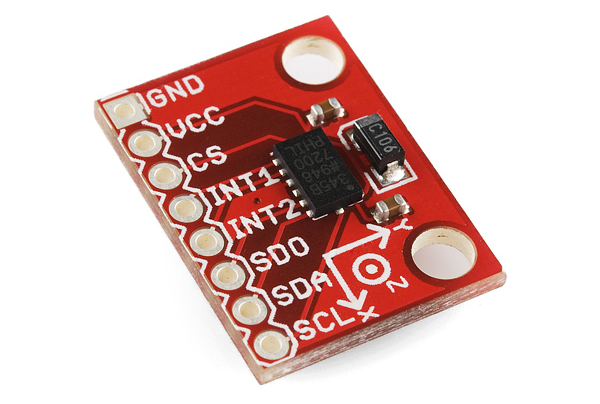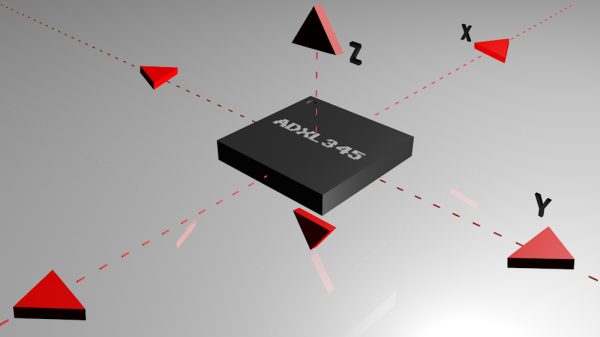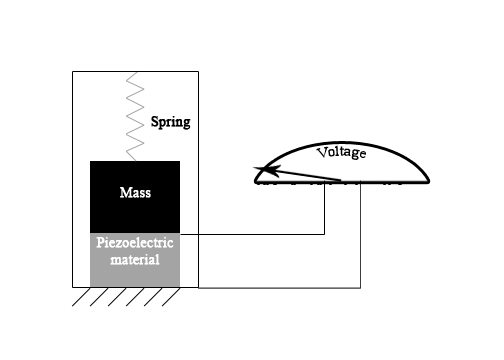Should an Accelerometer Read 1 G at Rest Dytran
What is an Accelerometer?
Accelerometers are devices that measure acceleration, which is the charge per unit of change of the velocity of an object. They measure in meters per second squared (1000/s2) or in G-forces (g). A single G-force for us here on planet Earth is equivalent to nine.8 chiliad/s2, but this does vary slightly with height (and will exist a different value on different planets due to variations in gravitational pull). Accelerometers are useful for sensing vibrations in systems or for orientation applications.

Suggested Reading
If you are unfamiliar with any of the topics below, you may want to read upwardly on those before moving alee with accelerometers.
Logic Levels
Learn the difference between iii.3V and 5V devices and logic levels.
I2C
An introduction to I2C, one of the primary embedded communications protocols in use today.
How an Accelerometer Works
Accelerometers are electromechanical devices that sense either static or dynamic forces of acceleration. Static forces include gravity, while dynamic forces can include vibrations and movement.

Axes of measurement for a triple axis accelerometer
Accelerometers can mensurate acceleration on one, two, or three axes. 3-centrality units are becoming more than common as the toll of development for them decreases.
Generally, accelerometers contain capacitive plates internally. Some of these are fixed, while others are attached to minuscule springs that move internally equally acceleration forces human activity upon the sensor. Equally these plates move in relation to each other, the capacitance between them changes. From these changes in capacitance, the acceleration can exist determined.
Other accelerometers can exist centered around piezoelectric materials. These tiny crystal structures output electrical charge when placed under mechanical stress ( e.thousand. acceleration).

An example of the inside of a piezoelectric accelerometer
How to Connect to an Accelerometer
For nearly accelerometers, the basic connections required for operation are ability and the communication lines. As always, read the datasheet to ensure proper connections are made.
Advice Interface
Accelerometers will communicate over an analog, digital, or pulse-width modulated connection interface.
-
Analog - Accelerometers with an analog interface show accelerations through varying voltage levels. These values mostly fluctuate between ground and the supply voltage level. An ADC on a microcontroller tin then be used to read this value. These are mostly less expensive than digital accelerometers.
-
Digital - Accelerometers with a digital interface tin can either communicate over SPI or I2C communication protocols. These tend to have more functionality and be less susceptible to noise than analog accelerometers.
-
Pulse-Width Modulation (PWM) - Accelerometers that output data over pulse-width modulation (PWM) output square waves with a known period, but a duty bicycle that varies with changes in acceleration.
Power
Accelerometers are generally low-power devices. The required current typically falls in the micro (µ) or milli-amp range, with a supply voltage of 5V or less. The current consumption can vary depending on the settings (e.chiliad., power saving way versus standard operating style). These different modes tin can make accelerometers well suited for battery powered applications.
Brand sure that proper logic levels are matched, especially with the digital interfaces.
How to Select an Accelerometer
When choosing which accelerometer to employ, several features are important to consider including power requirements and advice interfaces every bit discussed previously. Additional features for consideration are below.
Range
Almost accelerometers will have a selectable range of forces they can measure. These ranges can vary from ±1g up to ±250g. Typically, the smaller the range, the more sensitive the readings volition exist from the accelerometer. For instance, to measure small vibrations on a tabletop, using a small-range accelerometer will provide more than detailed data than using a 250g range (which is more than suited for rockets).

The ADXL362 Triple Axis Accelerometer can measure ±2g, ±4g, and ±8g.
Boosted Features
Some accelerometers include features such as tap detection (useful for low-power applications), free-fall detection (used for Active Hard Drive Protection), temperature bounty (to increase accuracy in dead reckoning situations ) and 0-1000 range sensing, which are other features to have into consideration when purchasing an accelerometer. The need for these types of features on the accelerometer will be adamant by the application in which the accelerometer is incorporated.
There are also IMUs (Inertial Measurement Units) available, which can include accelerometers, gyroscopes and even, occasionally, magnetometers into a single IC package or board. Some examples of this include the MPU6050 and MPU9150. These are commonly used in motility tracking applications and UAV guidance systems, where location and orientation of an object is important.
Purchasing an Accelerometer
At present that you lot've learned the abc'due south of the x's, y's, and z'south, take a expect at our recommended accelerometers.
Our Recommendations:
For a more in-depth look at choosing an accelerometer, take a expect at our buying guide to find the correct fit for your project.
Resources and Going Further
Yous should now accept all the basic tools and skills required to implement an accelerometer in your own project.
Please cheque out the post-obit links, to acquire more than about accelerometers:
- Accelerometer Buying Guide
- MMA8452Q Accelerometer Breakout Hookup Guide
- The Uncertain 7-Cube
- Das Blinken Top Lid
Source: https://learn.sparkfun.com/tutorials/accelerometer-basics/all
Postar um comentário for "Should an Accelerometer Read 1 G at Rest Dytran"